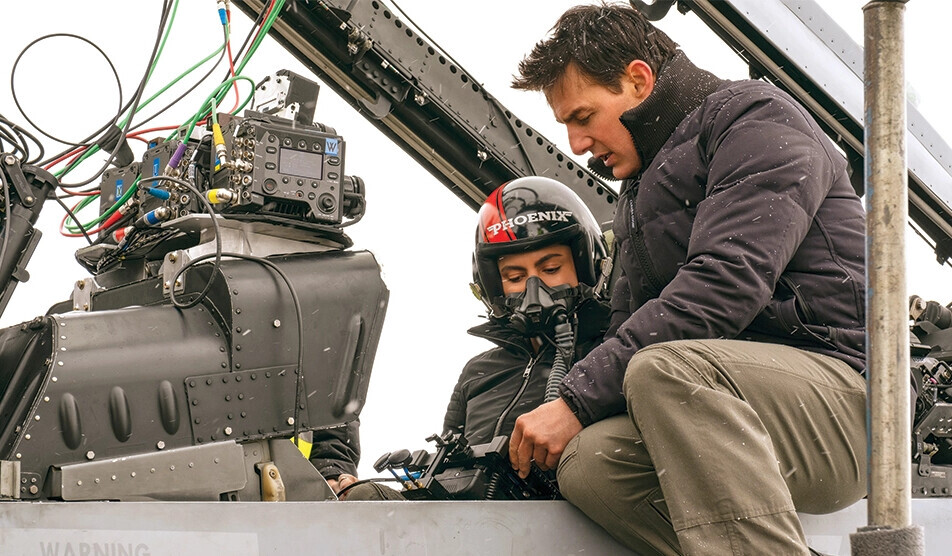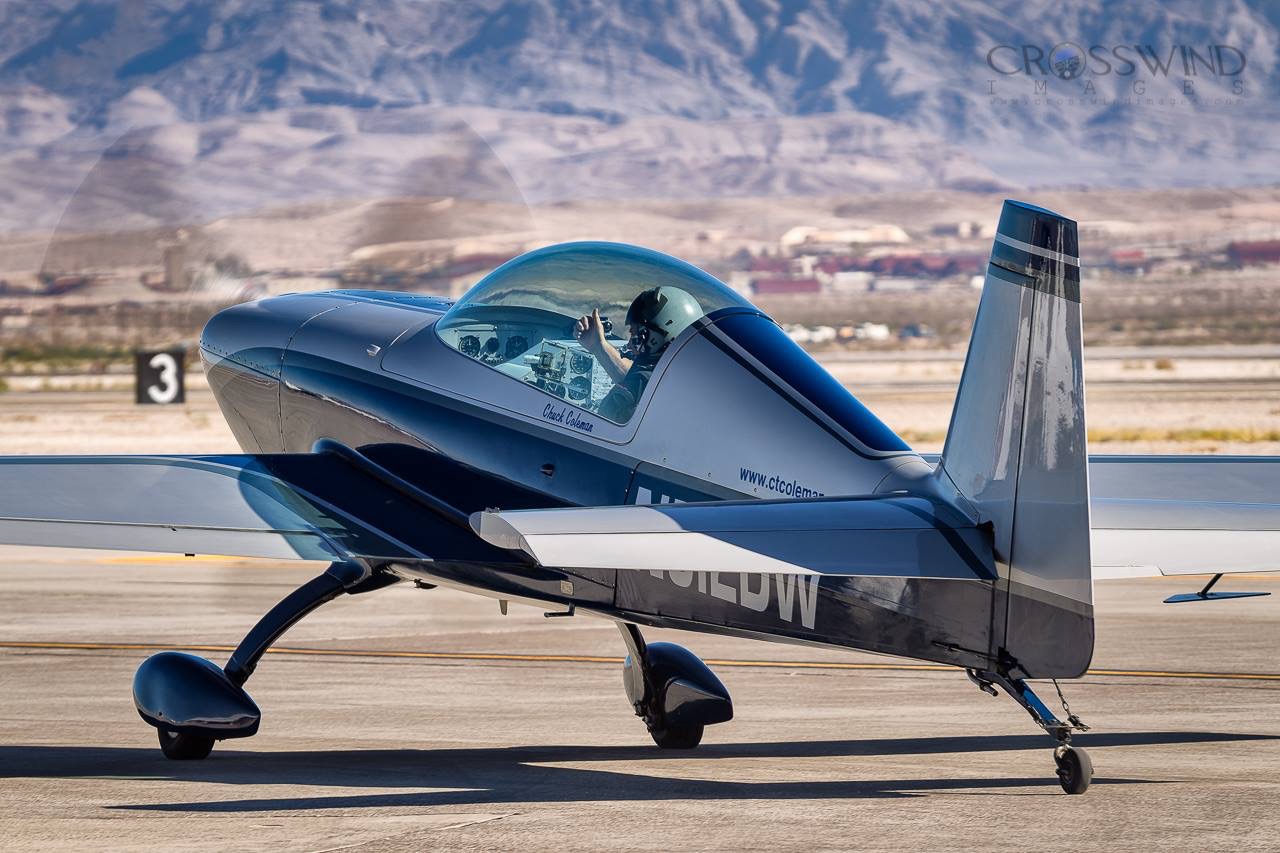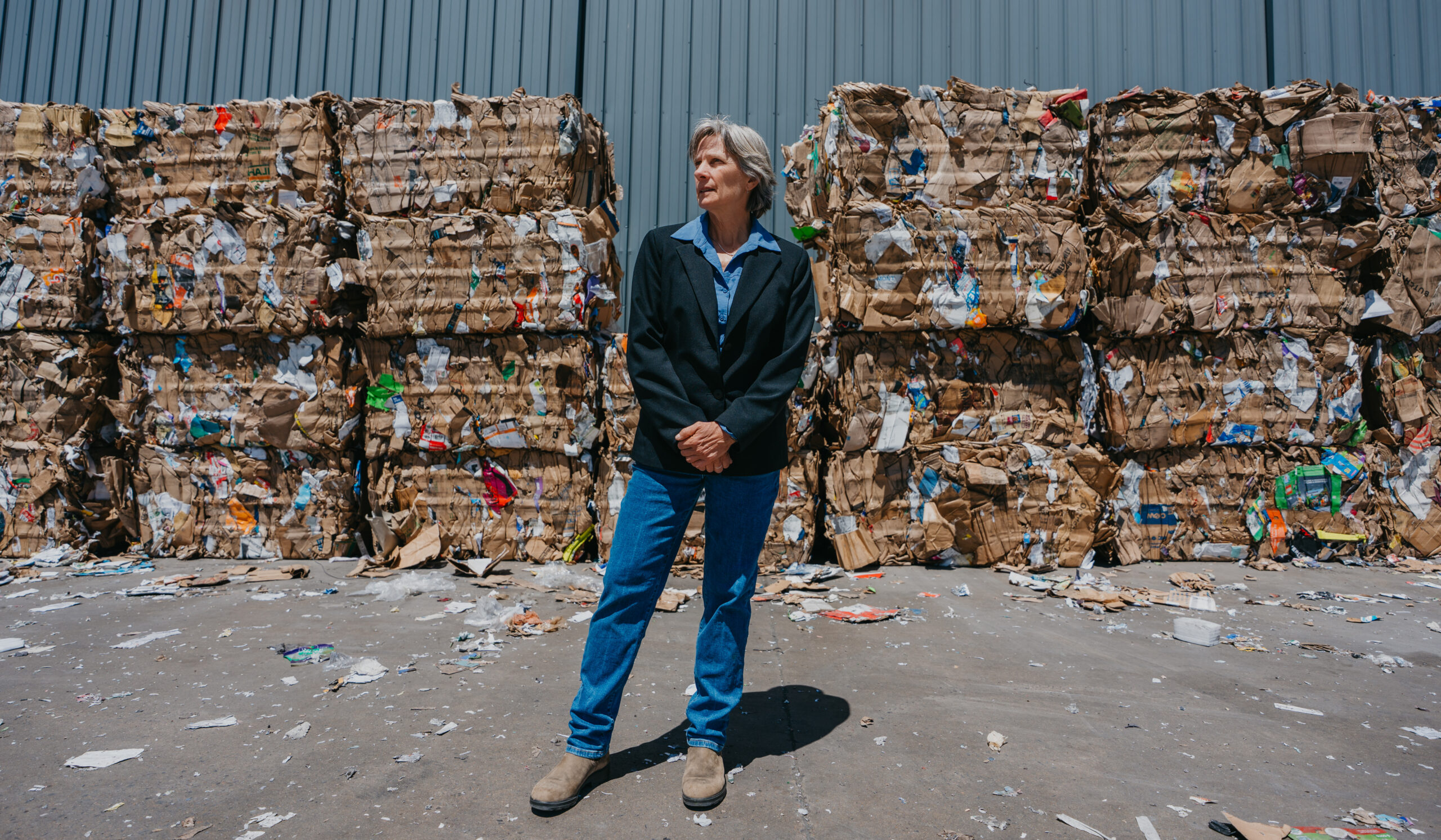Talk to Me, Chuck
•
Photo courtesy of Chuck Coleman
A vague call led Chuck Coleman, ’85, to a small airport in the desolate desert town of Inyokern, California, on a September morning: a major production company had requested his expertise in flying an Extra EA-300, the world’s most advanced aerobatic stunt plane.
Upon his arrival, Coleman was greeted by executive producers in the airport’s hangar where film crews had set the scene for filming “Top Gun: Maverick,” information he wasn’t privy to until mere minutes earlier. The U-M alum had been called on for various aviation documentaries and short films throughout his career, but never something quite like this.
“Tom Cruise wants to talk to you,” they told him. Moments later, he was shaking hands with “Maverick” himself.
36 years after “Top Gun” turned Cruise into a superstar, he was reprising his role as Capt. Pete Mitchell (known as Maverick), who the Navy drafts to train a squad of elite Boeing F/A-18F pilots for a dangerous mission to destroy an underground uranium plant on enemy land.
A trained pilot and aviation enthusiast in his real life, Cruise insisted that the sequel’s story could only be told one way: using real footage of real actors in real F/A-18 Super Hornet fighter jets. His commitment this time around was conditional on bringing the authentic, palpable thrill of the fighter pilot experience to the screens, not one heavily mimicked using CGI technology.
Earning approval from skeptical film executives, the actor designed an extensive flight course that condensed two years of flight training into three months, dubbed “Tom Cruise’s School of Flying.” The “grueling” training regimen utilized the world’s most incredible tactical aircrafts to accustom the actors to the fundamentals and mechanics of flight and gravitational forces (G-forces), preparing them to take flight with real Navy pilots in F/A-18 Super Hornets, each equipped with six IMAX-quality cameras.
Coleman’s resume made him Cruise’s perfect co-instructor, which is how he found himself in the middle of a desert hangar, newly tasked with the job.

The Art of Method Acting
Throughout his career, Coleman served as the senior design engineer for F/A-18 Hornet utilized by NASA and the United States Navy, including the Blue Angels flight demonstration team. As a commercial, test, and instructor pilot, he’s logged more than 10,800 hours of flight time (more than 4,400 hours in the Extra 300 series aircraft alone), has performed in hundreds of airshows, and given over 2,000 rides in aerobatic aircraft — but now, “Tom Cruise & Co.” was penciled into his books.
By October 2018, classes for “Tom Cruise’s School of Flying” were in session out of a Venice airport and the San Diego naval bases, used as the film’s main shooting locations. Coleman would spend roughly 100 days over the following eight months conducting 140 G-force tolerance flights in an Extra EA-300 with actors Glen Powell, Miles Teller, Monica Barbaro, Jay Ellis, Lewis Pullman, and Danny Ramirez.
Eyeballs rolling in their sockets like marbles, the face-morphing pull of gravity, instantaneous fainting and vomiting — the G-force of aerobatic aircraft stunting is not for the faint of heart. And unlike the first film, the actors in “Top Gun: Maverick” would actually be in the cockpits of the F/A-18s, acting and speaking their lines of dialogue mid-flight; capturing usable footage hinged on building the actors’ aerial tolerance and confidence.
“The main thing is when people first start flying, especially aerobics, they’re nervous, and that’s not the look for ‘Top Gun’ pilots,” Coleman quips, recalling how none of the eight actors had experience in small planes before the training, let alone aerobatic ones. “I just try to talk to them and be comforting because it’s crazy stuff that we’re doing in many people’s books.”
After basic flying training and introductory flights in a Cessna 172 single-engine plane, the actors graduated to an EA-300 with Coleman before advancing to the final part of the training scheme in L-39 jets. The idea was that, by the time they were put into a F/A-18, they were so accustomed to the G-forces that they could focus more on their character performance and less on worrying about flying through canyons in high-performance fighter jets.
Coleman took about 20 flights with each actor, introducing them to exhilarating aerobatic maneuvers, pulling loops and rolls as they ripped through the air, braving up to eight Gs.
After each flight, Coleman and the student actors wrote reviews that Cruise used to evaluate the actors’ progress and determine their readiness to film in F/A-18s.
“[Cruise] wanted to read the reviews right away because he’s a true aviation person that flies P51s and jets and everything else . . . and I think he learned from the first movie when they tried to film. It turned out everybody was sick, looking scared, looking funny. He wanted to get as much practical real footage as possible; that was the main objective.”
Coleman says each actor’s experience was different, but all were enthusiastic about the training and deeply dedicated to the process.
“Some would get sick almost every time, and some would not get sick at all. But even if they did get sick, within 10 seconds, they’d be clicked up, and say, ‘I’m ready to go, let’s continue,’” a scenario Coleman calls “rare.” It would be typical for a F/A-18 to land without any usable footage after an hour and a half flight due to G-force sickness. But the actors’ 140 flights with Coleman left them well-prepared to meet the seemingly unbearable G-force pressure and expectations of Capt. Maverick himself.
“When it came time for filming, I heard that they never had to come back on any of the F/A-18 flights because of [actors] getting sick, so that kind of made me go, ‘Well, we accomplished what Tom Cruise wanted to accomplish.’”
Coleman spent time on set and even sat in cockpits as the actors rehearsed lines, capturing glimpses of them coming to life as their pilot alter egos. He bonded with Cruise over their shared passion for aviation. He recalls the “deeply rewarding” experience of working closely with the actors whose dedication to the training brought this movie to life.
“You develop kind of a friendship with them, and we noticed that aviation was changing them. On one of my flights with Tom, we just talked the whole time about the training and everything. He said to me, ‘the confidence is improving in all of them,’ So I’m just, like, wow, Tom Cruise is telling me this. It’s just amazing.”
Following four years of training, filming, production, and pandemic delays, the highly-anticipated “Top Gun: Maverick” was released in theaters in May 2022 and was an immediate, sensational hit. Garnering nearly $1.5 billion in worldwide box office sales, the film is the 11th-highest-grossing film of all time and Cruise’s highest-grossing film ever.
“I’m sure at the end, the studios are probably thinking, ‘wow, look at what this evolved into and what it is doing,’” Coleman says, recalling the initial skepticism. “It was the result of a lot of things — a great team, teamwork. I mean, with the realistic camera footage, the actors, the confidence, everything just came together. It’s just so cool that I got to be a part of it.”

It Began with Maize & Blue
In the quaint farm town of St. John’s, Michigan, Coleman vividly remembers watching his parents’ black-and-white TV in awe as Neil Armstrong landed on the moon. Three years later, he watched Apollo 15 make the fourth human landing on the moon. That spacecraft was crewed by a team of U-M alums.
But Coleman never imagined his dreams would evolve from the tiny analog television in his parents’ living room to big screens across the world. He attributes his U-M education and its diverse experiences as the catalyst for it all.
“I saw that this stuff was possible, so when I’d think about what I wanted to do with my life, it all kind of led to this,” he says, sharing the tales of his nearly 40-year aviation and aerospace career, building spaceships, flying the world’s fastest planes, and training actors for the most famous aviation films in history.
“The education and diversity at Michigan is just incredible. I was from a small farming town, everybody was similar there, but you go to Michigan and see people from around the world that came there to learn,” he says. “I mean, look at the alumni — they are some of the best of all time, and Michigan made a difference in each of them, it’s a part of them.”
Coleman shares a particular connection with Clarence L. “Kelly” Johnson, ’33, MSE’33, HDENG’64, one of the most talented and prolific aircraft design engineers in the history of aviation.
As an aeronautical engineering student at U-M in the 1930s, Johnson gained the attention of Lockheed Aircraft Corporation after conducting wind tunnel tests of their proposed twin-engined airliner, leading to a job offer in 1933. Throughout his four-decade career with Lockheed, Johnson was renowned for his leadership of Skunk Works, Lockheed’s secret research and development team, and his contributions to many noteworthy aircraft designs, including the Lockheed U-2 and SR-71 Blackbird spy planes.
“He grew up in the Upper Peninsula, came down to the University of Michigan, and then he came out to California and did all of this amazing stuff. He created Skunk Works, which changed aviation and space forever, and he was kind of the early days of supersonic flight and everything.”

Coleman’s own move to California came in 2002, when he got a call from aerospace visionary Burt Rutan to join Scaled Composite and help design and build the first private spacecraft, SpaceShipOne.
He joined the team as a performance engineer, testing the spacecraft’s navigation system, conducting high-G astronaut training, and serving as the chase pilot. After launching in 2004, SpaceShipOne made three successful flights as the first privately developed spacecraft to carry a pilot to suborbital space. Today, it hangs proudly in the Air and Space Museum.
“This is a pioneering event that we did, and you’re always thinking about your background, where you came from, and how you got to that moment,” he says, fondly thinking of alums like Johnson and the Apollo 15 crew. “That’s why I try to do things that inspire people. I mean, ‘Top Gun: Maverick,’ the SpaceShipOne program, that’s the stuff that inspires all these kids that are just like I was, seeing a movie or spaceship flying and thinking, ‘I want to do that.’ So, that’s kind of our goal as alumni — continuing this great path that we’ve discovered.”
KATIE FRANKHART is a senior writer for the Alumni Association of the University of Michigan.



